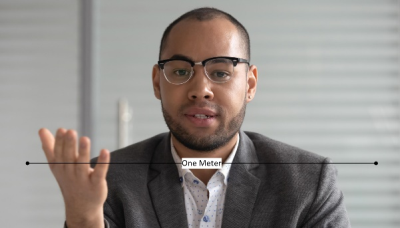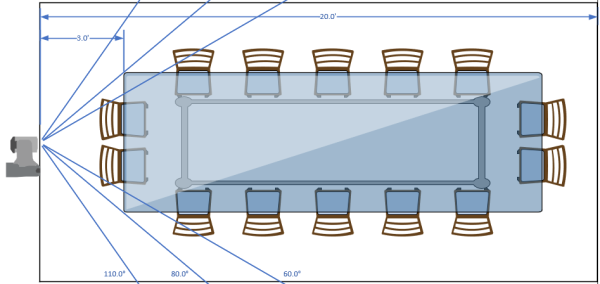Camera Basics
This topic covers the viewing angle, positioning, and lighting features and considerations of the NC Series cameras.
Angle of View / Field of View
The most important consideration about a camera is simply having it cover the intended area. This will determine the camera’s position and the angle of view it must have.
Wide-angle vs. telephoto
A PTZ camera's focal length of the zoom lens can be varied continuously to widen or narrow the camera’s angle of view. For teleconferencing in a meeting room, the widest angle is usually the most useful for capturing an image of participants seated around a table. A tighter, telephoto, angle is usually best for viewing a single speaker or presenter. A one-meter-wide view can comfortably frame a single person in a bust shot. This is important because a moderate telephoto shot is more appealing than having the camera closer and covering the same view with a wide-angle shot. For zoom and field of view calculations for all Q-SYS cameras, see the interactive camera calculator on the NC Series product page on the QSC website.

What NC Series camera model should I choose?
In a video conference application, the camera typically needs to cover everyone attending the meeting within its field of view. In a standard application, the camera needs to be close to the participants. Its angle of view must be wide enough to include all attendees. Select the appropriate camera based on the angle and zoom distance needed.
In this image, the angles of the three NC Series cameras are drawn to depict the portion of the given room which will be within the field of view. For a room type like this, the NC-12x80 would be ideal, and the NC-110 would be overkill. The NC-20x60 would cut off some of the participants.

And in this image, the room is rotated 90° and the camera is placed 4 ½ feet from the edge of the table. In this situation, the NC-110 is the ideal selection for including the entire table in a single shot. The NC-12x80 and NC-20x60 will not image the entirety of the table in a single shot but instead offer a mechanical pan and tilt option to move the image as necessary.

Wide angle caveats
-
Extremely wide angles of view exaggerate distances and make small rooms look large. This can result in meeting participants appearing smaller than they should, or more distant to the viewer.
-
Avoid using a wide angle for a close-up, as it can exaggerate facial features.
Tip: A moderate telephoto shot from a reasonable distance will appear more natural.
Positioning
The angle of view, the desired viewing area, and the position of the camera are all directly related. For conferencing, a camera position slightly above eye level is ideal. Mounting the camera too far above eye level (for example, on top of a large flat panel monitor) can result in an eagle-eye-view where the camera appears to be significantly above the participants and is looking down on them from overhead.
Tip: The result of proper camera positioning is the appearance of meeting room participants making eye contact with remote viewers.
Lighting
NC Series cameras have automatic gain control (AGC) and excellent low-light sensitivity, with a minimum illuminance level of only 0.5 lux at widest angle. For comparison:
-
A full moon on a clear night typically provides about 0.27 to 1.0 lux
-
Typical TV studio lighting is about 1000 lux
-
Typical office lighting is about 500 lux
Even with a high-quality camera that has great low-light performance – as with the NC Series cameras – picture quality improves sharply with improved lighting. The camera boosts its gain very high to compensate for very low light levels, which can result in more noticeable video noise or grain. Camera autofocus systems are also less effective in very low light. Ensuring suitable lighting is a simple and effective way of improving image quality.
Lighting recommendations
-
For the best performance, QSC recommends at least 300 lux in the camera's environment.
-
For videoconferencing, lighting should be even for all participants. This will avoid the appearance that some attendees are in the dark.
-
Lighting should be diffused to minimize harsh or awkward shadows.
